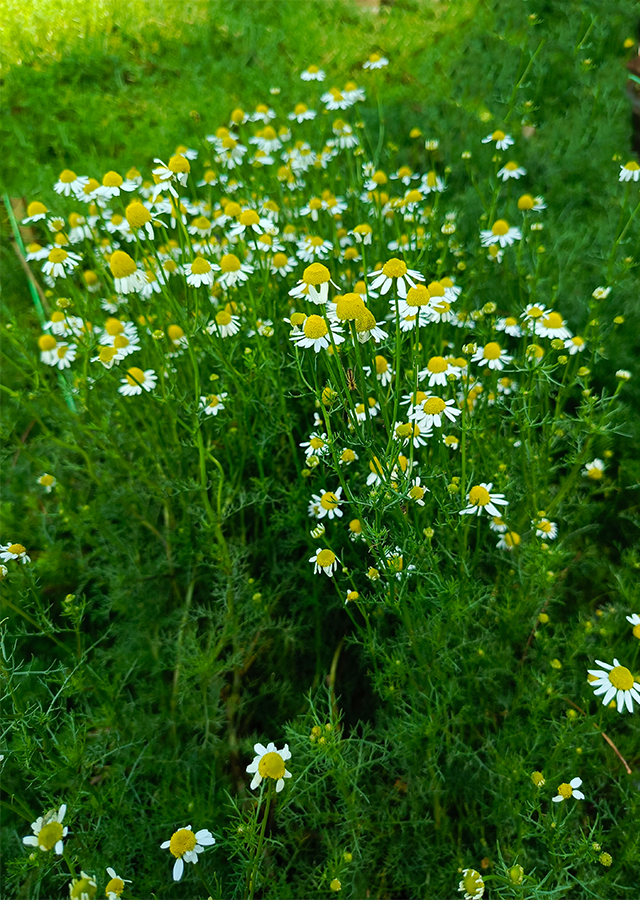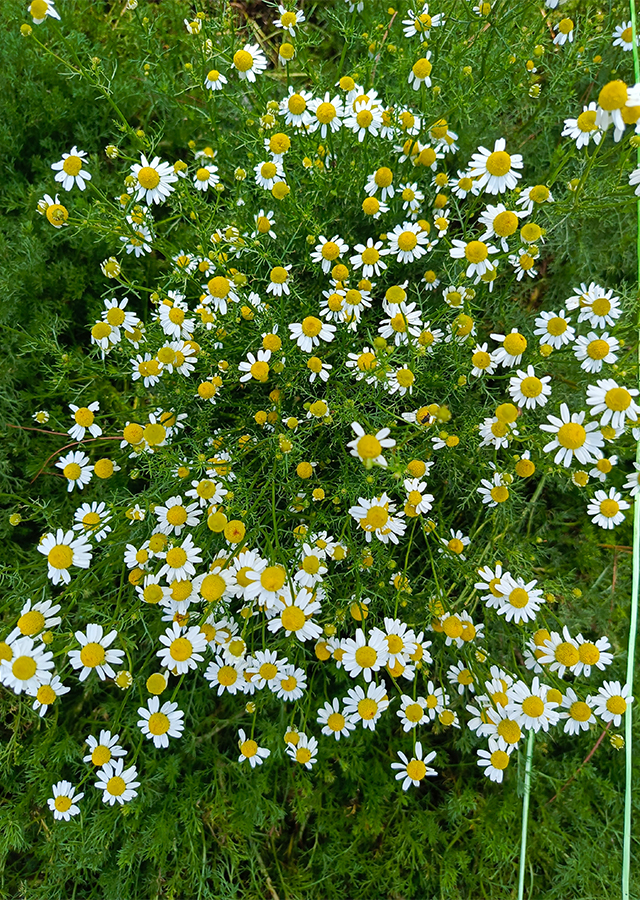Chamomile
Matricaria chamomilla L.
Asteraceae
Location in our garden
Principal



Synonym
Chamaemelum chamomilla (L.) E.H.L.Krause
Chrysanthemum chamomilla (L.) Bernh.
Chamomilla recutita (L.) Rauschert
Habitus
Herbaceous. An erect, annual plant that grows 10–80 cm tall.
Part Used
Leaves
Flowers
Stem
The Whole Plant
Growing Requirements
Full Sunshine
Habitat
Roadside
Overview
Matricaria chamomilla is native to southern and eastern Europe. It is also grown in Germany, Hungary, France, Russia, Yugoslavia, and Brazil. It was introduced to India during the Mughal period, now it is grown in Punjab, Uttar Pradesh, Maharashtra, and Jammu and Kashmir. The plants can be found in North Africa, Asia, North and South America, Australia, and New Zealand. It is one of the important medicinal herb that has been used in herbal remedies for thousands of years, known in ancient Egypt, Greece, and Rome. This herb has been believed by Anglo-Saxons as 1 of 9 sacred herbs given to humans by the lord. The chamomile drug is included in the pharmacopoeia of 26 countries. It is an ingredient of several traditional, unani, and homeopathy medicinal preparations. The essential oil present in the flower heads and is used in perfumery, cosmetic creams, hair preparations, skin lotions, tooth pastes, and also in fine liquors. The dry flowers of chamomile are also used in herbal tea and baby massage oil. Yellow to gold dyes are obtained from the flowers. The international demand for chamomile oil has been steadily growing. As a result, the plant is widely cultivated in Europe and has been introduced in some Asian countries for the production of its essential oil.
Vernacular Names
Echte Kamille (German), Manzanita comun (Spanish).
Agroecology
Chamomile can be found on sandy or loamy arable soils, and also on saline steppes. A weedy species, preferring sunny sites (slightly shaded sites are tolerated) and found on wasteland, roadsides and fields. It grows best in areas where annual daytime temperatures are within the range 19-25 °C, but can tolerate 6-30 °C. When dormant, the plant can survive temperatures down to about -5 °C, but young growth can be severely damaged at 0 °C. It prefers a mean annual rainfall in the range 700-1,000 mm, but tolerates 300-1,300 mm. An easily grown plant, it succeeds in any well-drained soil in a sunny position and can tolerate light shade. It prefers neutral to slightly acid conditions and succeeds in poor soils and moderately saline conditions. Prefers a pH in the range 5.5-6.5, tolerating 5-7.
Morphology
- Root - thin spindle-shaped roots.
- Stem - erect, heavily ramified.
- Leaves - long and narrow leaves are bi- to tripinnate.
- Flower - flower heads are placed separately, they have a diameter of 10–30 mm, pedunculate and heterogamous. The golden yellow tubular florets with 5 teeth are 1.5–2.5 mm long, ending always in a glandulous tube. The 11–27 white plant flowers are 6–11 mm long, 3.5 mm wide, and arranged concentrically. The receptacle is 6–8 mm wide, flat in the beginning and conical, cone-shaped later, hollow (the latter being a very important distinctive characteristic of Matricaria) and without paleae.
- Fruit - yellowish brown achene.
Cultivation
- The plant is generatively propagated by seeds - sow in situ.
- Seed germination starts within 4–5 days of sowing, and the seedlings area ready for transplanting within 4–5 weeks. Seedlings older than 5 weeks should not be transplanted; it results in a poor and indifferent crop.
Chemical Constituents
Sesquiterpenes, flavonoids (quercetin and rutin), essential oils (azulene, chamazulene, α-bisabolol, β-farnesene), coumarins (herniarin, umbelliferone), polyacetylenes, phenylpropanoids lorogenic acid and caffeic acid).
Traditional Medicinal Uses
- Chamomile is used mainly as an antiinflammatory and antiseptic, also antispasmodic and mildly sudorific.
- It is used internally mainly as a tisane (infuse 1 table-spoonful of the drug in 1 L of cold water and do not heat) for disturbance of the stomach associated with pain, for sluggish digestion, for diarrhea and nausea; more rarely and very effectively for inflammation of the urinary tract and for painful menstruation.
- Externally, the drug in powder form may be applied to wounds slow to heal, for skin eruptions, and infections, such as shingles and boils, also for hemorrhoids and for inflammation of the mouth, throat, and the eyes.
- It is used for flatulence, colic, hysteria, and intermittent fever.
- Chamomile tea eye washing can induce allergic conjunctivitis.
Part Used
Reference Sources
- Fern, Ken. (2022). Useful Tropical Plants: Matricaria chamomilla. https://tropical.theferns.info/viewtropical.php?id=Matricaria+chamomilla. 26-11-2022.
- GBIF. (No date). Matricaria chamomilla L. https://www.gbif.org/species/8370958. 26-11-2022.
- Kew Royal Botanic Gardens. (No date). Plants of the World Online: Matricaria chamomilla L. https://powo.science.kew.org/taxon/urn:lsid:ipni.org:names:154715-2. 26-11-2022.
- Singh, Ompal, et al. (2011). Chamomile (Matricaria chamomilla L.): An overview. Pharmacogn Rev. 2011 Jan-Jun; 5(9): 82–95. doi: 10.4103/0973-7847.79103. Also available: https://www.ncbi.nlm.nih.gov/pmc/articles/PMC3210003/.


